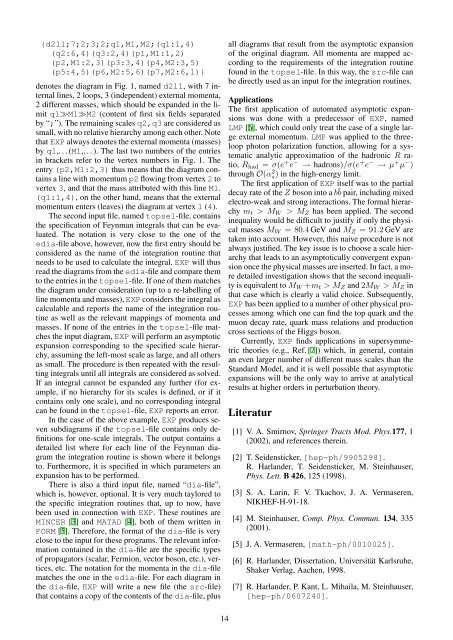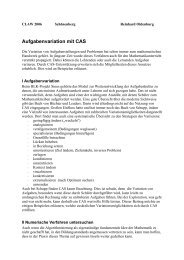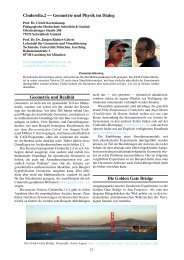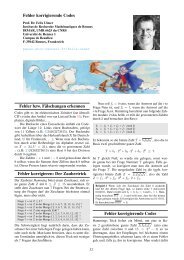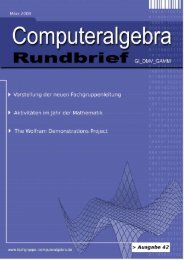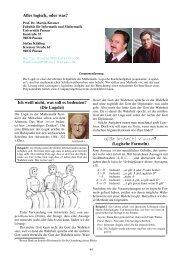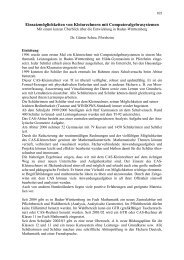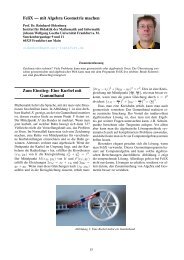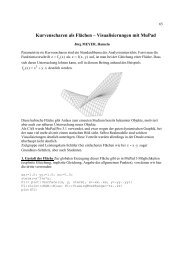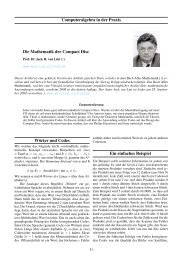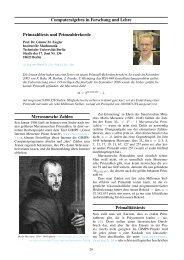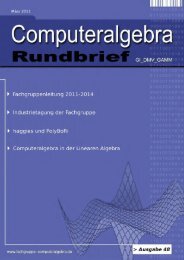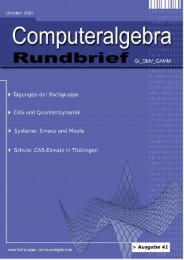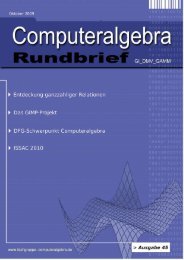mathemasordinate - Fachgruppe Computeralgebra
mathemasordinate - Fachgruppe Computeralgebra
mathemasordinate - Fachgruppe Computeralgebra
Sie wollen auch ein ePaper? Erhöhen Sie die Reichweite Ihrer Titel.
YUMPU macht aus Druck-PDFs automatisch weboptimierte ePaper, die Google liebt.
{d2l1;7;2;3;2;q1,M1,M2;(q1:1,4)<br />
(q2:6,4)(q3:2,4)(p1,M1:1,2)<br />
(p2,M1:2,3)(p3:3,4)(p4,M2:3,5)<br />
(p5:4,5)(p6,M2:5,6)(p7,M2:6,1)}<br />
denotes the diagram in Fig. 1, named d2l1, with 7 internal<br />
lines, 2 loops, 3 (independent) external momenta,<br />
2 different masses, which should be expanded in the limit<br />
q1≫M1≫M2 (content of first six fields separated<br />
by “;”). The remaining scales q2,q3 are considered as<br />
small, with no relative hierarchy among each other. Note<br />
that EXP always denotes the external momenta (masses)<br />
by q1,. . . (M1,. . . ). The last two numbers of the entries<br />
in brackets refer to the vertex numbers in Fig. 1. The<br />
entry (p2,M1:2,3) thus means that the diagram contains<br />
a line with momentum p2 flowing from vertex 2 to<br />
vertex 3, and that the mass attributed with this line M1.<br />
(q1:1,4), on the other hand, means that the external<br />
momentum enters (leaves) the diagram at vertex 1 (4).<br />
The second input file, named topsel-file, contains<br />
the specification of Feynman integrals that can be evaluated.<br />
The notation is very close to the one of the<br />
edia-file above, however, now the first entry should be<br />
considered as the name of the integration routine that<br />
needs to be used to calculate the integral. EXP will thus<br />
read the diagrams from the edia-file and compare them<br />
to the entries in the topsel-file. If one of them matches<br />
the diagram under consideration (up to a re-labelling of<br />
line momenta and masses), EXP considers the integral as<br />
calculable and reports the name of the integration routine<br />
as well as the relevant mappings of momenta and<br />
masses. If none of the entries in the topsel-file matches<br />
the input diagram, EXP will perform an asymptotic<br />
expansion corresponding to the specified scale hierarchy,<br />
assuming the left-most scale as large, and all others<br />
as small. The procedure is then repeated with the resulting<br />
integrals until all integrals are considered as solved.<br />
If an integral cannot be expanded any further (for example,<br />
if no hierarchy for its scales is defined, or if it<br />
contains only one scale), and no corresponding integral<br />
can be found in the topsel-file, EXP reports an error.<br />
In the case of the above example, EXP produces seven<br />
subdiagrams if the topsel-file contains only definitions<br />
for one-scale integrals. The output contains a<br />
detailed list where for each line of the Feynman diagram<br />
the integration routine is shown where it belongs<br />
to. Furthermore, it is specified in which parameters an<br />
expansion has to be performed.<br />
There is also a third input file, named “dia-file”,<br />
which is, however, optional. It is very much taylored to<br />
the specific integration routines that, up to now, have<br />
been used in connection with EXP. These routines are<br />
MINCER [3] and MATAD [4], both of them written in<br />
FORM [5]. Therefore, the format of the dia-file is very<br />
close to the input for these programs. The relevant information<br />
contained in the dia-file are the specific types<br />
of propagators (scalar, Fermion, vector boson, etc.), vertices,<br />
etc. The notation for the momenta in the dia-file<br />
matches the one in the edia-file. For each diagram in<br />
the dia-file, EXP will write a new file (the src-file)<br />
that contains a copy of the contents of the dia-file, plus<br />
14<br />
all diagrams that result from the asymptotic expansion<br />
of the original diagram. All momenta are mapped according<br />
to the requirements of the integration routine<br />
found in the topsel-file. In this way, the src-file can<br />
be directly used as an input for the integration routines.<br />
Applications<br />
The first application of automated asymptotic expansions<br />
was done with a predecessor of EXP, named<br />
LMP [6], which could only treat the case of a single large<br />
external momentum. LMP was applied to the threeloop<br />
photon polarization function, allowing for a systematic<br />
analytic approximation of the hadronic R ratio,<br />
Rhad = σ(e + e − → hadrons)/σ(e + e − → µ + µ − )<br />
through O(α 2 s) in the high-energy limit.<br />
The first application of EXP itself was to the partial<br />
decay rate of the Z boson into a b ¯ b pair, including mixed<br />
electro-weak and strong interactions. The formal hierarchy<br />
mt > MW > MZ has been applied. The second<br />
inequality would be difficult to justify if only the physical<br />
masses MW = 80.4 GeV and MZ = 91.2 GeV are<br />
taken into account. However, this naive procedure is not<br />
always justified. The key issue is to choose a scale hierarchy<br />
that leads to an asymptotically convergent expansion<br />
once the physical masses are inserted. In fact, a more<br />
detailed investigation shows that the second inequality<br />
is equivalent to MW +mt > MZ and 2MW > MZ in<br />
that case which is clearly a valid choice. Subsequently,<br />
EXP has been applied to a number of other physical processes<br />
among which one can find the top quark and the<br />
muon decay rate, quark mass relations and production<br />
cross sections of the Higgs boson.<br />
Currently, EXP finds applications in supersymmetric<br />
theories (e.g., Ref. [7]) which, in general, contain<br />
an even larger number of different mass scales than the<br />
Standard Model, and it is well possible that asymptotic<br />
expansions will be the only way to arrive at analytical<br />
results at higher orders in perturbation theory.<br />
Literatur<br />
[1] V. A. Smirnov, Springer Tracts Mod. Phys.177, 1<br />
(2002), and references therein.<br />
[2] T. Seidensticker, [hep-ph/9905298].<br />
R. Harlander, T. Seidensticker, M. Steinhauser,<br />
Phys. Lett. B 426, 125 (1998).<br />
[3] S. A. Larin, F. V. Tkachov, J. A. Vermaseren,<br />
NIKHEF-H-91-18.<br />
[4] M. Steinhauser, Comp. Phys. Commun. 134, 335<br />
(2001).<br />
[5] J. A. Vermaseren, [math-ph/0010025].<br />
[6] R. Harlander, Dissertation, Universität Karlsruhe,<br />
Shaker Verlag, Aachen, 1998.<br />
[7] R. Harlander, P. Kant, L. Mihaila, M. Steinhauser,<br />
[hep-ph/0607240].


